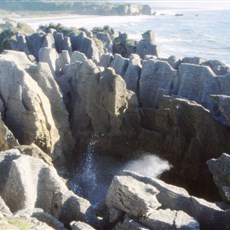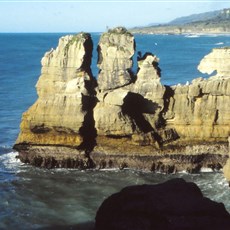2000 Biking New Zealand
Day 10, 17 December 2000, Sunday
Ross – Punakaiki; 119.8km @ 18kph, Punakaiki Beach Hostel, $44
We awoke to the crowing of a cock. And
breakfasted again on muesli. And hit the road encountering quite hilly terrain
initially, but then uninspiring scenery (flatter with less features all around,
but quick cycling, good weather, no wind) until well beyond Hokitika. We also
crossed several long single-lane bridges some of which carried train tracks.
Before each of these a very graphic road sign depicting a cyclist falling on
his head because his wheel is caught in the rail track furrow warned of the
additional dangers of cycling on these narrow bridges!
At times we were so close to the ocean the
smell of the Tasman Sea was strong on the
breeze – particularly on the long bridge into Hokitika on which we could also
feel mist-gentle sea spray. Hokitika is the first sizeable town we have
encountered on the west cost. Its tourist industry is based on Greenstone
carving, as well as bone and wood carving. Quite attractive with a Boer War
memorial to fallen soldiers prominent in the centre of town and lots of tourist
shops open (the greenstone carving is either cheap and nasty or very beautiful
and very expensive – nothing tempted me to part with my money) and restaurants
serving inter alia yummy croissants on which we mid-morning-snacked.
Greenstone had been carved by the Maori for
centuries, though less so in the last century. The local industry was revived
over a beer after a huge slab of greenstone was discovered by a man out hunting
deer. Once Haast Pass was opened in 1965, bringing with
it a flood of tourists, the industry boomed.
Back on the thankfully windless road north
to Kumara Junction where the road splits – the right hand fork going over the
apparently-fabulous Arthur’s Pass to Christchurch, the left
taking us northwards still along the coast. Soon after the Junction and 27km
from Hokitika, we stopped for another break at the Tramway Tavern where we sat
in the sunshine in the garden by the river and refuelled our engines. We sat
under a tree from which a bizarre variety of goods dripped having been flung
into the branches from below. Named the Georie Tree (for some inexplicable
reason), the practise of throwing old T-shirts and mechanical oddments etc into
the tree apparently began spontaneously in 1998 to the amusement, I suspect, of
drunken locals. When I walked into the pub to place our order the proprietor
and her three guests made a snide aside and then were friendly – silly
behaviour for adults. Just as we were leaving a family preparing for a pub
party that night arrived. They asked whence we were headed and the woman said
it was very hilly after Greymouth and that she would not care for it. Her more
optimistic husband said the hills were only up half the time (!) – a useless
truism.
So back on the road on a still hot day with
bell birds again punctuating the air with their creaky-swing calls. With the
Tasman quite often close enough for us to feel its spray on our hot bodies;
with broken headlands like exclamations offshore; with numerous tough climbs in
the afternoon heat; with great views back and forward along the coast. And with
tall sparsely-topped palms to left and right. New Zealand is the southernmost
limit for palms.
Through attractive Greymouth (a big town)
to Barrytown where we rested again in a pub only just opened that week. And
then onward to Punakaiki feeling progressively more tired. Outside Greymouth we
encountered a young couple hitch hiking. The young man stuck out his thumb as I
passed him and I said he was welcome to a lift provided he pedalled – an offer
he laughingly declined. A little later I saw them go by in a vehicle – giving
me a friendly wave and a smile. I caught up with them again later standing in
splendid isolation on the roadside. When Charl passed them a little later, they
apparently yelled that he was eight minutes behind me! Later still they again
passed us – this time for the last time. While I was photographing left-behind
headlands, Charl behind me on the road was conversing with a Benoni family
enjoying their holiday in New
Zealand.
Just after the long climb into Punakaiki we
parked our bikes and went to see the famous Pancake Rocks and blowholes –
unfortunately having missed the 4pm high tide which makes the blowholes more
spectacular. But enjoyed our half hour there anyway. 35 million years ago sea
creatures died here and their shells and skeletons formed limestone deposits.
Between the layers of limestone, layers of mudstone (compacted minerals) were deposited.
Over time the mudstone washed out emphasising the limestone layers and creating
the effect of a pancake stack. Numerous stacks now sit well out of the water,
some straight some tumbled; waves gushing up into hollows between them. Could
have spent more time here.
Down the other side of the hill then to our
green and yellow hostel on the beach – very casual and laid-back. There to
barefoot-stroll briefly down to the sea, to shower and sit in the hottub
overlooking the ocean and drink our cognac, and to dress in our ever-so-cute
room. After which we enjoyed an excellent pub meal (seafood platter for Charl,
pasta for me) in the one-block-away and extremely popular pub. We shared our
table with a couple from the east coast on a kayaking weekend. He is an
engineer and the two of them have lived in Botswana and elsewhere. They were
telling us how great it was to get ‘free’ healthcare in New Zealand –
and were a little put out when we said no country could afford to provide free
healthcare to its rich. Pleasant, nonetheless.
We’ve had a tough day, and have a tougher
one ahead of us!

En route Punakaiki

En route Punakaiki

En route Punakaiki

En route Punakaiki

En route Punakaiki

Pancake Rocks - Punakaiki

Pancake Rocks - Punakaiki

Pancake Rocks - Punakaiki

Pancake Rocks - Punakaiki

Pancake Rocks - Punakaiki